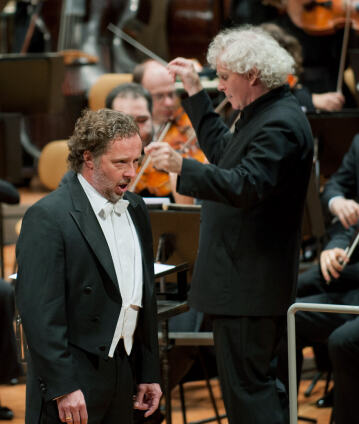Simon Rattle and Christian Gerhaher

Primitive power as if from a wild, faraway past mixes with the vibrancy of the modern in Leoš Janáček’s Glagolitic Mass. An eye to the past and the future is also evident in Gustav Mahler’s Lieder eines fahrenden Gesellen which combine innovative expression with a Romantic, folk-like sound. The soloist is Christian Gerhaher. The conductor is Simon Rattle, who also presents Witold Lutosławski’s Second Symphony.
When the Berliner Philharmoniker first performed Witold Lutosławski’s Second Symphony in March 1970, they provoked contrary audience reactions: booing and bravos clashed loudly. At the time, the work’s seemingly disparate musical language met with little understanding. Lutosławski’s Second Symphony is an extremely tension-fraught piece with two very contradictory parts: a hesitant, episodic first movement and a forward-pressing, purposeful second movement.
Gustav Mahler’s Lieder eines fahrenden Gesellen, in which the composer came to terms with his unrequited love for the soprano Johanna Richter, left listeners unimpressed at first. The orchestral version premiered in March 1896 with the “Berlin Philharmonisches Orchester”. Mahler had hired the orchestra at his own expense to present several of his works to the public. Besides a lack of interest in the event, reviewers were not very complimentary. “Nonetheless, I would not like to deny Mr Mahler any talent. If only he were not searching so frantically for originality.” (Zeitschrift für Musik)
This is in stark contrast to Leoš Janáček’s Glagolitic Mass, which was already enthusiastically received at its premiere in 1927. Though Janáček set a Slavonic mass text to music, the work is anything but archaic, dogmatic or reactionary. Instead, the Czech composer created a composition full of drama and vitality – testimony to his humanist, pan-Slavic worldview.
© 2013 Berlin Phil Media GmbH
Related interviews
Artists
Our recommendations
- Kirill Petrenko conducts Schulhoff, Sinigaglia and Zemlinsky
- “Pelléas et Mélisande” with Simon Rattle, Christian Gerhaher and Magdalena Kožená
- Mikko Franck conducts Schumann’s “Paradise and the Peri”
- Antonello Manacorda and Christian Gerhaher
- Kirill Petrenko conducts Mendelssohn’s “Elijah”
- Daniel Harding conducts Schumann’s “Scenes from Goethe’s Faust”